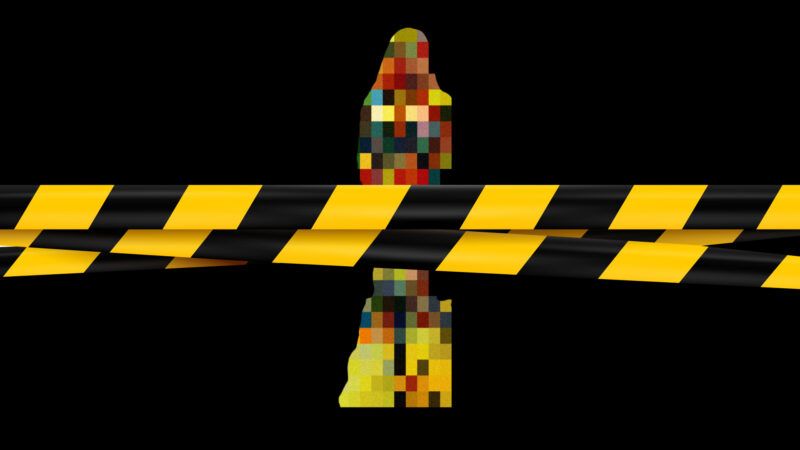After Muslim Students Complained That an Art Exhibit Was 'Harmful,' Macalester College Shut It Down
"My artwork is unapologetic," said the artist. "Sometimes it can be very political. Sometimes it can be very controversial."

Yet another Minnesota college is embroiled in a controversy after a group of Muslim students expressed outrage over "offensive" art. Last month, Macalester College—a liberal arts college just two miles from Hamline University, where a similar controversy involving an adjunct art history professor erupted in December—briefly shut down an exhibit from an Iranian-American artist over student claims that some of the work displayed caused "harm."
While the school later reinstated the art exhibit, it wasn't without caveats. Now, pages of construction paper are posted on the glass gallery doors to block the work from view, along with a "content warning." The incident is yet another example of university administrators caving into unreasonable student demands and setting a troubling precedent that paves the way for further censorship.
On January 27, an exhibition by Iranian-American artist Taravat Talepasand opened in Macalester College's Law Warschaw gallery. According to a statement that accompanies the exhibit, the work "explores the cultural taboos that reflect on gender and political authority." It includes works like a sculpture reading "Woman, Life, Freedom" in English and Farsi, a watercolor of a man beheading two women, and a painting depicting a teddy bear and a Ken doll, called Mohammed Meets Jesus.
However, a handful of works sparked student outrage. Two drawings, Blasphemy X and Blasphemy IX portray women wearing niqabs pulling up their robes to reveal lingerie. A series of porcelain sculptures portray women who are entirely veiled, save for comically exaggerated breasts.
The exhibition "just feels a bit targeting because there's not that many Muslim students here," one student, who circulated a petition denouncing the work, told the Sahan Journal. "At a predominantly white institution, when I'm looking at who's attending the school, who's walking into this exhibit, without understanding and nuance, then it's quite harmful."
"The decision to display and continue to display this exhibition despite the harm it perpetuates is a deeply problematic issue," the petition reads. "It is targeting and harming an already small community that exists on this campus." The petition has so far only gained 80 signatures, but it seems this was more than enough to get administrators to act.
The school temporarily closed the exhibition, erecting black curtains to obscure the art. Later, administrators sent a campus-wide email announcing that while they would be reopening the exhibit due to "the value and importance of artistic expression," there would be several changes. The school has now placed several sheets of construction paper over the glass doors leading to the gallery to "prevent unintentional or non-consensual viewing of certain works," and posted a content warning.
"Unfortunately, as the Taravat exhibition was installed, we did not take the steps needed to demonstrate cultural sensitivity and awareness of the possible impact of the art. For this and for the harm it caused, we apologize," administrators wrote in the email.
Talepasand told the Sahan Journal that while, at first, she didn't object to the brief closure after hearing about the student outrage, "Nobody told me about the black curtain veiling all the windows. That's a whole other level of censorship." Talepasand also took issue with the phrasing of the content warning, which states that the exhibit "contains images of sexuality and violence that may be upsetting or unacceptable for some viewers." She called this a "violation."
This case is possibly the "first time a college has employed the curious phrase 'non-consensual viewing of certain works,'" wrote Sarah McLaughlin, director of the targeted advocacy program at the Foundation for Individual Rights and Expression, a First Amendment nonprofit. "It's, frankly, a rather sinister way to define controversial imagery: not just as something that could offend or upset, but as something that violates an accidental viewer's consent. It's a comically bad lesson to teach students."
While it's good news that Macalester chose to reopen the gallery, school administrators never should have caved to student outrage and closed it in the first place. Further, the use of content warnings and visually blocking the art still sends the message that if art offends students' religious sensibilities, Macalester administrators are happy to hide it away.
"My artwork is unapologetic," Talepasand told the Sahan Journal. "I'm making work that's finding the similarities, not just differences, between East and West and how, in a lot of ways, they parallel. Sometimes it can be very political. Sometimes it can be very controversial."



Show Comments (52)